Gentle stretches quiet your racing mind by leveraging the powerful mind-body connection. As you stretch, you activate your parasympathetic nervous system, lowering heart rate and blood pressure. This physical relaxation sends signals to your brain, promoting mental calmness. Focused breathing during stretches acts as a form of moving meditation, shifting your awareness from anxious thoughts to present bodily sensations. The improved circulation from stretching enhances cognitive function and mental clarity. Regular practice not only increases flexibility but also boosts overall well-being, reducing stress and tension. By incorporating simple stretches into your daily routine, you'll discover a natural way to calm your mind and body.
Key Takeaways
- Gentle stretching activates the parasympathetic nervous system, lowering heart rate and blood pressure to promote relaxation.
- Focused attention during stretching acts as a moving meditation, shifting awareness from racing thoughts to bodily sensations.
- Stretching enhances blood flow and oxygen delivery to the brain, improving cognitive function and mental clarity.
- The mind-body connection allows physical relaxation through stretching to positively influence mental state and reduce stress.
- Breath awareness and mindfulness during stretches anchor attention to the present moment, calming anxious thoughts.
The Mind-Body Connection
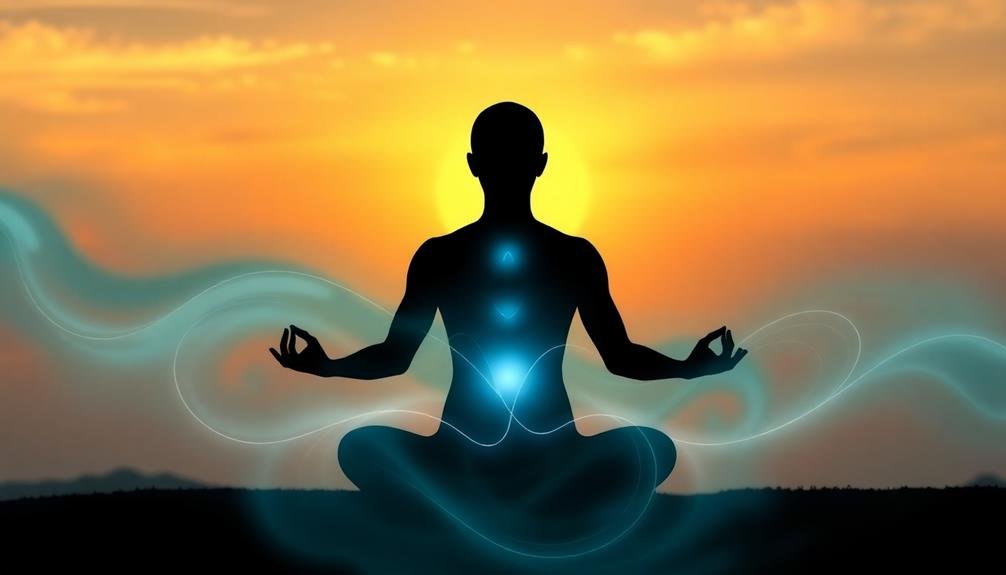
We often underestimate the profound link between our physical and mental states. Your body and mind are intricately connected, constantly communicating through a complex network of nerves, hormones, and chemical messengers. When you're stressed, your muscles tense up, and when you're relaxed, they loosen. This bidirectional relationship means that by consciously relaxing your body, you can influence your mental state.
Gentle stretching is a powerful tool to exploit this mind-body connection. As you stretch, you're not just elongating muscles; you're sending signals to your brain that it's safe to relax. This triggers a cascade of physiological responses, including a decrease in stress hormones like cortisol and an increase in feel-good neurotransmitters like serotonin.
Moreover, stretching encourages deep, mindful breathing, which further calms your nervous system. It also improves blood flow, delivering more oxygen to your brain and enhancing cognitive function.
Physiological Effects of Gentle Stretching

Building on the mind-body connection, let's examine the specific physiological changes that occur during gentle stretching. When you engage in slow, deliberate stretches, your body responds in several ways that contribute to a calmer state of mind.
First, gentle stretching activates your parasympathetic nervous system, which is responsible for the "rest and digest" response. This activation lowers your heart rate, reduces blood pressure, and slows your breathing. As you stretch, you'll notice your muscles gradually relaxing, releasing tension that's often held subconsciously.
Stretching also increases blood flow throughout your body, including to your brain. This improved circulation delivers more oxygen and nutrients, enhancing cognitive function and promoting a sense of mental clarity. Additionally, the act of stretching stimulates the production of endorphins, your body's natural mood elevators.
The focused attention required for gentle stretching serves as a form of moving meditation. As you concentrate on your body's sensations and movements, you're naturally drawn away from racing thoughts, allowing your mind to settle.
This mindful approach to stretching can greatly reduce stress and anxiety levels, leaving you feeling more centered and composed.
Breath Awareness During Stretches

The rhythm of your breath serves as an anchor during gentle stretching exercises. As you move through each stretch, focus on your breathing to deepen the mind-body connection. Inhale slowly through your nose, feeling your lungs expand, and exhale gently through your mouth, releasing tension with each breath.
Sync your movements with your breath. As you ease into a stretch, breathe in deeply, allowing your body to lengthen. Hold the stretch as you exhale, feeling your muscles relax further. This coordinated breathing enhances the stretch's effectiveness and promotes a sense of calm.
Pay attention to the quality of your breath. If it becomes shallow or rapid, it's a sign you're pushing too hard. Ease back and focus on maintaining slow, steady breaths. This mindful approach helps prevent injury and keeps you present in the moment.
As you become more aware of your breath during stretches, you'll notice how it influences your overall state. Deep, controlled breathing activates your parasympathetic nervous system, reducing stress and promoting relaxation.
This combination of gentle movement and focused breathing creates a meditative experience, quieting your mind and fostering a sense of inner peace.
Releasing Tension Through Movement

As you move through gentle stretches, focus on releasing tension from your muscles.
By consciously relaxing each muscle group, you'll strengthen the connection between your mind and body.
This practice not only eases physical discomfort but also promotes mental calmness, helping you cultivate a quieter mind.
Muscle Relaxation Techniques
After completing your stretches, it's time to focus on releasing tension through targeted muscle relaxation techniques. These methods can help you further calm your mind and body, enhancing the benefits of your gentle stretching routine.
By systematically tensing and relaxing specific muscle groups, you'll become more aware of physical sensations and learn to let go of built-up stress.
To practice progressive muscle relaxation, follow these steps:
- Find a comfortable position, either sitting or lying down
- Take a few deep breaths to center yourself
- Start with your toes, tensing them for 5-10 seconds, then releasing
- Work your way up through each muscle group, including your legs, abdomen, arms, and face
As you move through this process, you'll notice a sense of warmth and heaviness in your relaxed muscles. This technique not only helps release physical tension but also promotes mental calmness.
You'll find that as your body relaxes, your mind follows suit, quieting racing thoughts and reducing anxiety. With regular practice, you'll develop a greater ability to recognize and release tension throughout your day, leading to improved overall well-being.
Mind-Body Connection Benefits
Beyond the physical benefits, gentle stretching and movement create a powerful mind-body connection. As you stretch, you'll notice your awareness shifting from racing thoughts to the sensations in your body. This focused attention helps quiet your mind, reducing stress and anxiety.
When you move mindfully, you're engaging in a form of moving meditation. You'll become more attuned to your body's signals, helping you identify and release areas of tension you may not have been aware of. This increased body awareness can lead to better posture, improved breathing, and a greater sense of overall well-being.
Gentle stretching also triggers the release of endorphins, your body's natural feel-good chemicals. These hormones can elevate your mood, reduce pain perception, and promote a sense of calm. As you practice regularly, you'll likely find yourself better equipped to handle stress and maintain emotional balance throughout your day.
The mind-body connection fostered through gentle stretching can also improve your sleep quality, boost your immune system, and enhance your cognitive function. You'll likely experience increased mental clarity, improved focus, and better decision-making abilities as a result of this practice.
Mindfulness in Stretching Practice

In the midst of your stretching practice, cultivating mindfulness can transform a simple physical routine into a powerful tool for mental clarity and relaxation.
As you move through each stretch, focus on being fully present in the moment. Notice the sensations in your body, the rhythm of your breath, and the subtle shifts in your muscles.
To deepen your mindfulness during stretching:
- Set an intention: Begin your practice by deciding what you'd like to focus on, such as releasing tension or improving flexibility.
- Scan your body: Before stretching, take a moment to mentally scan your body from head to toe, noting any areas of tightness or discomfort.
- Breathe mindfully: Coordinate your stretches with your breath, inhaling as you prepare and exhaling as you deepen the stretch.
- Observe without judgment: Notice any thoughts or feelings that arise during your practice without labeling them as good or bad.
Grounding Techniques for Anxious Thoughts
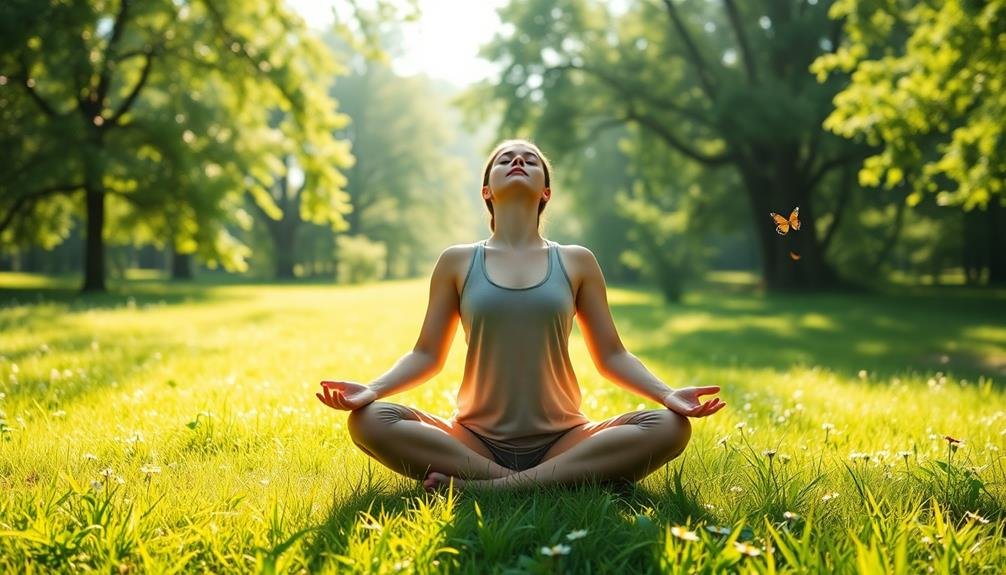
When anxious thoughts arise during your stretching practice, you can employ grounding techniques to regain calm.
Start by focusing on physical sensations in your body, then breathe with intention to anchor yourself in the present moment.
Focus on Physical Sensations
As your mind races with anxious thoughts, grounding yourself in physical sensations can provide a powerful anchor. By focusing on your body's physical experiences, you're redirecting your attention away from worrying and into the present moment. This shift can help calm your nervous system and reduce anxiety.
To practice focusing on physical sensations:
- Start with your feet: Feel the pressure of the floor against your soles. Notice the temperature and texture of the surface beneath you.
- Move up to your legs: Pay attention to the weight of your body on your legs and any sensations in your muscles.
- Focus on your hands: Touch different textures around you, noticing their unique feels. Rub your palms together, concentrating on the warmth and friction.
- Tune into your breath: Feel the air moving in and out of your nose or mouth. Notice your chest or belly rising and falling with each breath.
Breathe With Intention
Building on the practice of focusing on physical sensations, intentional breathing offers another powerful grounding technique for anxious thoughts. As you stretch, pay attention to your breath, using it as an anchor to keep your mind present. Breathe deeply and slowly, inhaling through your nose and exhaling through your mouth.
Try different breathing patterns to find what works best for you:
| Breathing Technique | How to Practice |
|---|---|
| Box Breathing | Inhale for 4, hold for 4, exhale for 4, hold for 4 |
| 4-7-8 Technique | Inhale for 4, hold for 7, exhale for 8 |
| Belly Breathing | Place hand on belly, breathe deeply into diaphragm |
| Alternate Nostril | Close one nostril, inhale, switch, exhale |
| Counted Breaths | Count each inhale and exhale up to 10, then restart |
As you practice intentional breathing during your stretches, you'll notice your mind becoming calmer and more focused. This combination of gentle movement and mindful breathing helps interrupt the cycle of anxious thoughts, bringing you back to the present moment. Remember, consistency is key – the more you practice, the more effective these techniques become in quieting your racing mind.
Connect With Environment
Throughout your stretching routine, connecting with your environment can provide additional grounding for anxious thoughts. As you move through each stretch, take a moment to engage your senses and become fully present in your surroundings. Notice the textures beneath your feet, the temperature of the air on your skin, and the subtle sounds around you.
To deepen your connection with your environment, try these grounding techniques:
- Focus on five objects you can see, four things you can touch, three sounds you can hear, two scents you can smell, and one taste in your mouth.
- Describe your surroundings in detail, either mentally or aloud, noting colors, shapes, and patterns.
- Pick up a nearby object and explore its texture, weight, and temperature with your hands.
- If you're outdoors, feel the earth beneath you by walking barefoot on grass or sand.
Gentle Stretches for Stress Relief
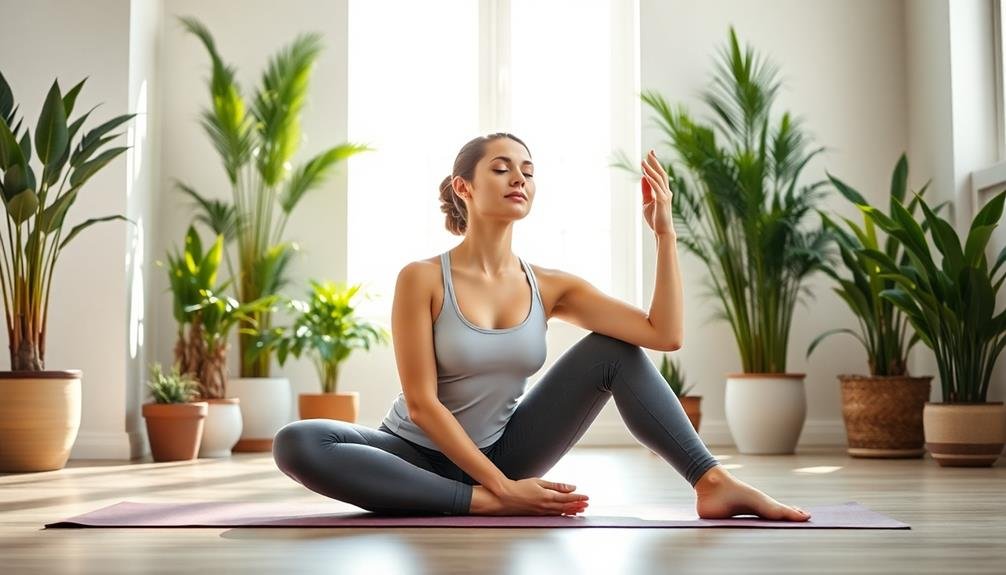
When stress takes hold, your body often tenses up, exacerbating feelings of anxiety and discomfort. Gentle stretches can help release this tension and calm your racing mind.
Start with your neck and shoulders, areas prone to holding stress. Slowly roll your head in circles, then gently tilt it side to side. Next, shrug your shoulders up to your ears, hold for a few seconds, and release.
Move to your back with a gentle spinal twist. Sit cross-legged, place one hand behind you, and twist your torso, looking over your shoulder. Hold for 30 seconds, then switch sides.
For your legs, try a seated forward bend. Extend your legs in front of you, reach for your toes, and hold the stretch for a minute.
Don't forget your arms and wrists, especially if you work at a computer. Extend one arm in front of you, palm up. Use your other hand to gently pull your fingers back towards your body. Hold for 15 seconds, then switch arms.
These simple stretches can help alleviate physical tension, promoting a sense of calm and mental clarity.
Creating a Calming Stretch Routine
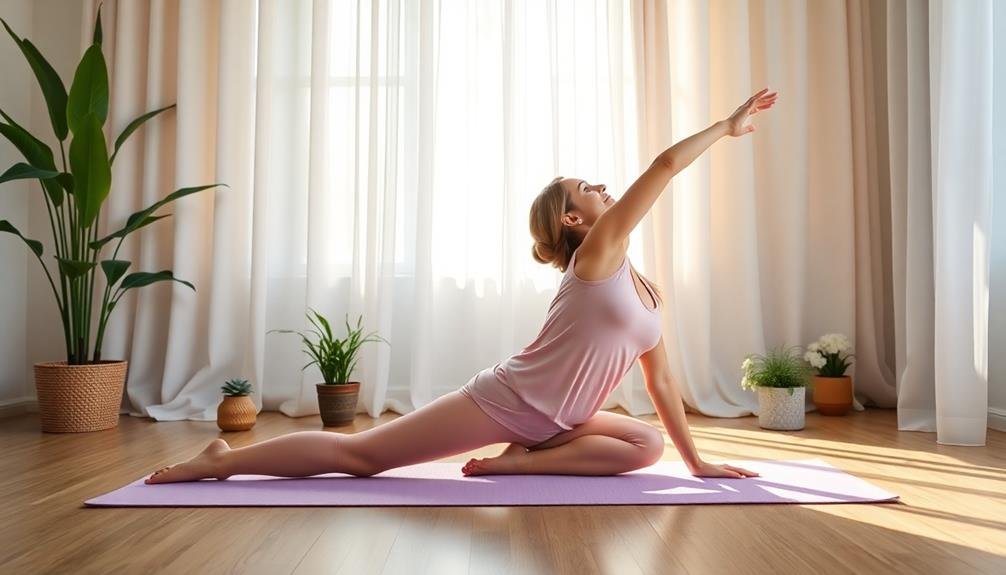
A calming stretch routine can become your daily sanctuary for stress relief and mental clarity. To create an effective routine, focus on gentle movements that encourage deep breathing and mindfulness.
Start by choosing a quiet, comfortable space where you won't be disturbed. Set aside 10-15 minutes, preferably at the same time each day, to establish a consistent practice.
When designing your routine, include a mix of stretches that target different areas of your body. Consider incorporating these elements:
- Gentle neck rolls and shoulder shrugs to release upper body tension
- Slow, controlled twists to improve spinal mobility and stimulate digestion
- Forward folds to stretch the hamstrings and lower back while calming the nervous system
- Child's pose or other restorative poses to promote relaxation and introspection
Remember to move slowly and breathe deeply throughout your routine. Pay attention to how each stretch feels in your body, and don't push beyond your limits.
As you practice regularly, you'll likely notice improvements in your flexibility, posture, and overall sense of well-being. Your calming stretch routine will become a cherished part of your day, helping you cultivate a quieter mind and a more centered approach to life's challenges.
Benefits of Regular Stretching
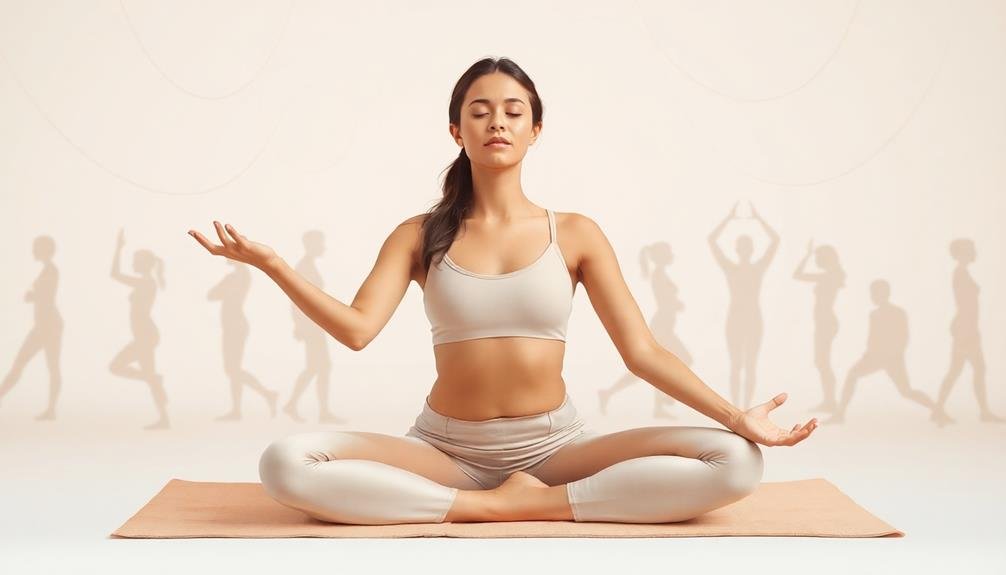
Regular stretching offers you more than just physical relaxation.
You'll experience improved flexibility and mobility, allowing for easier movement in daily activities.
Additionally, you'll notice reduced muscle tension and enhanced blood circulation, which can contribute to an overall sense of well-being.
Improved Flexibility and Mobility
Three key benefits of regular stretching are improved flexibility, enhanced mobility, and increased range of motion.
These improvements can greatly impact your daily life, making everyday activities easier and more enjoyable. As you incorporate gentle stretches into your routine, you'll notice your body becoming more supple and responsive.
Improved flexibility allows you to move more freely, reducing the risk of injury and muscle strain.
You'll find it easier to:
- Reach for items on high shelves
- Bend down to tie your shoes
- Twist your body to look behind you while driving
- Perform household chores with greater ease
Enhanced mobility means you'll be able to move through a wider range of motions without discomfort.
This can lead to better posture, reduced joint stiffness, and improved athletic performance.
You'll also experience increased blood flow to your muscles, which can help alleviate soreness and promote faster recovery after physical activity.
Reduced Muscle Tension
Incorporating gentle stretches into your routine can considerably reduce muscle tension throughout your body. As you stretch, you'll feel tightness in your muscles begin to release, promoting a sense of physical and mental relaxation. This reduction in tension can alleviate chronic pain and discomfort, improving your overall quality of life.
Regular stretching helps break the cycle of muscle tension that often accompanies stress and anxiety. By focusing on areas that tend to hold tension, such as your neck, shoulders, and lower back, you'll experience immediate relief and long-term benefits. Here's a quick guide to target these common tension areas:
| Area | Stretch | Duration |
|---|---|---|
| Neck | Gentle neck rolls | 30 seconds |
| Shoulders | Shoulder shrugs | 15 reps |
| Lower back | Cat-cow pose | 1 minute |
As you consistently practice these stretches, you'll notice improved posture and a decrease in tension headaches. Your body will become more resilient to stress, and you'll find it easier to maintain a calm, centered state throughout the day. Remember, even a few minutes of gentle stretching can make a significant difference in reducing muscle tension and promoting overall well-being.
Enhanced Blood Circulation
Stretching out your muscles leads to a significant boost in blood circulation throughout your body. As you lengthen and flex your muscles, you're encouraging blood flow to areas that might've been constricted or underserved. This increased circulation brings a host of benefits that contribute to both physical and mental well-being.
When you stretch regularly, you'll notice:
- Improved oxygen delivery to your brain, enhancing cognitive function and mental clarity
- Faster removal of metabolic waste products from your muscles, reducing fatigue and soreness
- Enhanced nutrient distribution to your tissues, promoting better overall health and healing
- Increased body temperature, which can help you feel more relaxed and comfortable
The enhanced blood flow from stretching doesn't just benefit your muscles; it affects your entire body. You'll likely experience improved skin health, better digestion, and even a stronger immune system.
As your circulation improves, you may find yourself feeling more energized and alert throughout the day. This boost in blood flow can also help regulate your body temperature, making you feel more comfortable in various environments.
Incorporating Stretches Into Daily Life

Seamlessly weaving stretches into your daily routine can transform your approach to relaxation and mindfulness. Start by identifying pockets of time throughout your day where you can incorporate brief stretching sessions.
Wake up a few minutes earlier to perform gentle morning stretches, helping you ease into the day with a calm mind. During work breaks, stand up and do some simple desk stretches to refresh your body and mind.
While watching TV or waiting for your coffee to brew, use that time to stretch your legs or practice gentle neck rolls. Before bed, engage in a relaxing stretching routine to release the day's tension and prepare for restful sleep.
Don't forget to stretch during mundane activities like brushing your teeth or waiting in line. Set reminders on your phone or place sticky notes around your home and workspace to prompt you to stretch regularly.
Frequently Asked Questions
Can Stretching Replace Meditation for Stress Relief?
While stretching can be calming, it can't fully replace meditation for stress relief. You'll find both practices complement each other well. Stretching focuses on physical relaxation, while meditation addresses mental aspects. Try incorporating both for ideal stress management.
Are There Age Restrictions for Practicing Gentle Stretches?
You can practice gentle stretches at any age. There's no upper limit, but you'll want to be more cautious as you get older. Always listen to your body and consult a doctor if you have health concerns.
How Long Should Each Stretching Session Last for Optimal Mental Benefits?
For ideal mental benefits, you'll want to aim for 10-15 minutes of gentle stretching. You can break this into shorter sessions throughout the day if you're short on time. Listen to your body and don't overdo it.
Can Stretching Help With Sleep Disorders or Insomnia?
Yes, stretching can help with sleep disorders and insomnia. You'll find that gentle stretches before bed can relax your muscles, reduce tension, and calm your mind. It's a natural way to prepare your body for better sleep.
Are There Any Potential Risks or Contraindications for Gentle Stretching?
While gentle stretching is generally safe, you should be cautious if you have injuries, chronic conditions, or recent surgeries. Don't overstretch or bounce. If you're pregnant or have balance issues, take extra care. Always listen to your body's limits.
In Summary
You've learned how gentle stretches can calm your racing mind. By embracing the mind-body connection, focusing on your breath, and practicing mindfulness, you're giving yourself powerful tools to manage stress. Remember, it's not about perfecting poses, but about tuning into your body and releasing tension. Start small, incorporating brief stretching moments into your day. You'll soon notice the difference in your mental clarity and overall well-being. Keep stretching, keep breathing, keep calming.

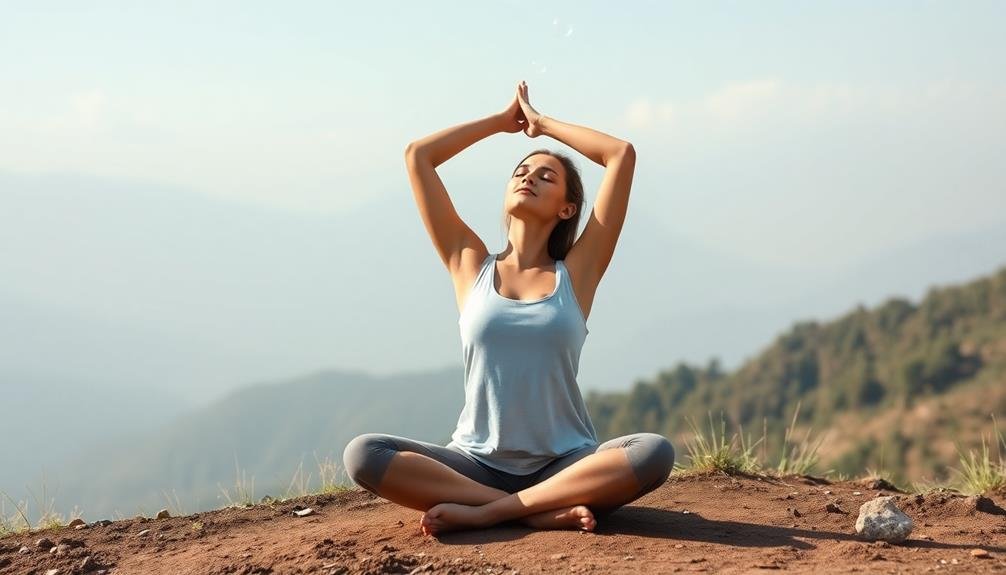
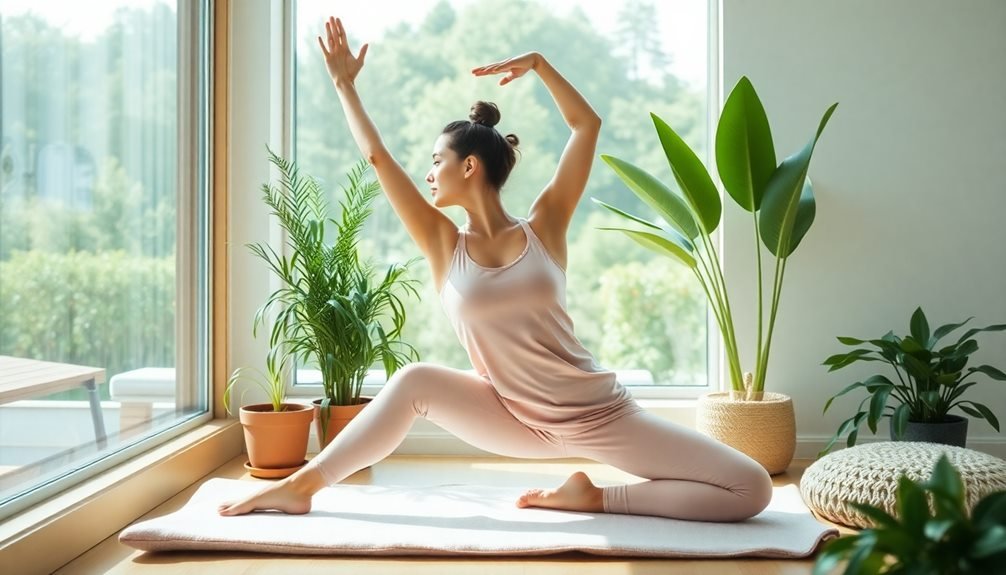
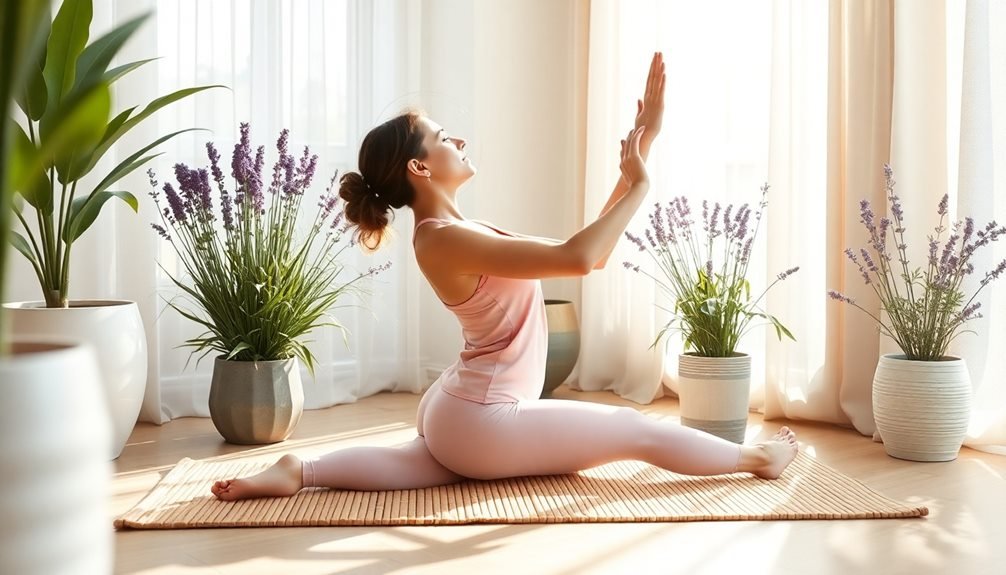
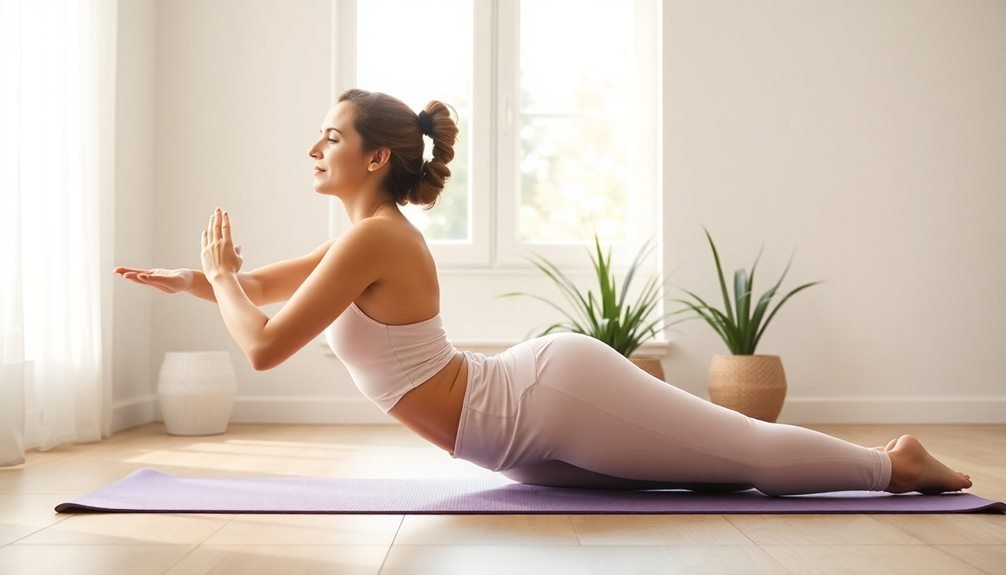
Leave a Reply